The DEXIS IS 3800W is one of 8 different wireless intraoral scanners currently on the market, including TRIOS 5, Medit i700, the AS 200E and the recently released Primescan 2.
Carestream Dental released this scanner (previously called Carestream Dental 3800) back in 2021, but in 2022 Envista Holdings acquired Carestream Dental's entire intraoral scanner business and rebranded it as DEXIS IS 3800W.
Over the past 2 years, the company has been hard at work relaunching this product, leveraging many other brands under its umbrella like the successful Spark aligners and Nobel Biocare + Implant Direct implants.
Notably, they have put a lot of effort building quite an amazing software that runs the scanner but also a comprehensive imaging ecosystem and data hub with some interesting AI pieces. This is called DTX Studio Clinic - more on that later.
So given all the new software changes, I figured its time to revisit this scanner and review it again to showcase what Envista has been building.

DEXIS IS 3800W is one of the most lightweight and smallest wireless scanners on the market.
Image courtesy of my friend 小池軍平.
In this review, I will share my experience with the DEXIS IS 3800W in which I’ll cover various aspects of the IOS, including its design and ergonomics, scanning performance, software ecosystem, and pricing, to help you make an informed decision on whether this scanner is the right fit for your dental practice.
As always, this is a completely objective review based on my own experiences. We do not sell the DEXIS IS 3800W nor is this a sponsored post. iDD pioneered unbiased digital dentistry reviews, and it is one of our core values. Therefore I will continue to provide you with information you can rely on.
Enjoy the review.
Review At a Glance
The DEXIS IS 3800W is a capable scanner even though it is close to 3 years old. Envista has invested a ton of resources into the software called DTX Studio Clinic, which is one of the hidden gems in the industry and is actually quite impressive.
Pros:
Cons:
Check out our full Unboxing video of the DEXIS IS 3800 W below:
Download the Full Review PDF

Download the full 24 page PDF to get a full copy of this article to read later.
Get a high resolution printable copy of this review.
DEXIS IS 3800W Scan Speed
Scanning speed is no longer a discussion point with modern intraoral scanners.
The DEXIS IS 3800W is another ‘fast’ intraoral scanner. Full arch scans within 45 seconds or so. All scanners are basically fast these days for most indications.
The DEXIS IS 3800W can quickly capture intraoral scans, with the software stitching them together rapidly. The scanner itself is capable, even though it is 3 years old. This is a much better scanner than the previous generation Carestream Dental scanners.
It handled every indication thrown at it well - crowns, bridges, implants, edentulous. I even tested all on x, bloody scans, tissue scans, etc. It did well overall, which in this competitive market is basically an expectation.
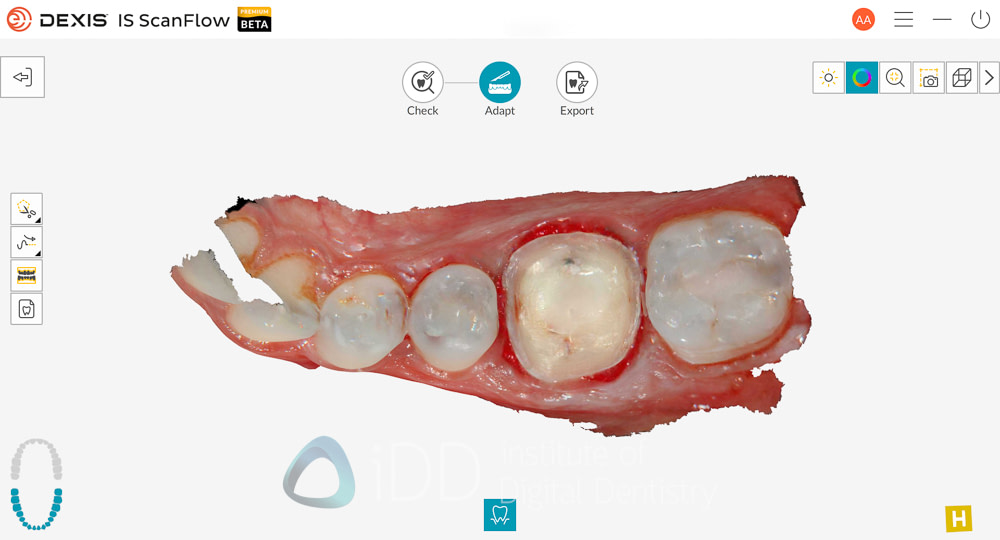
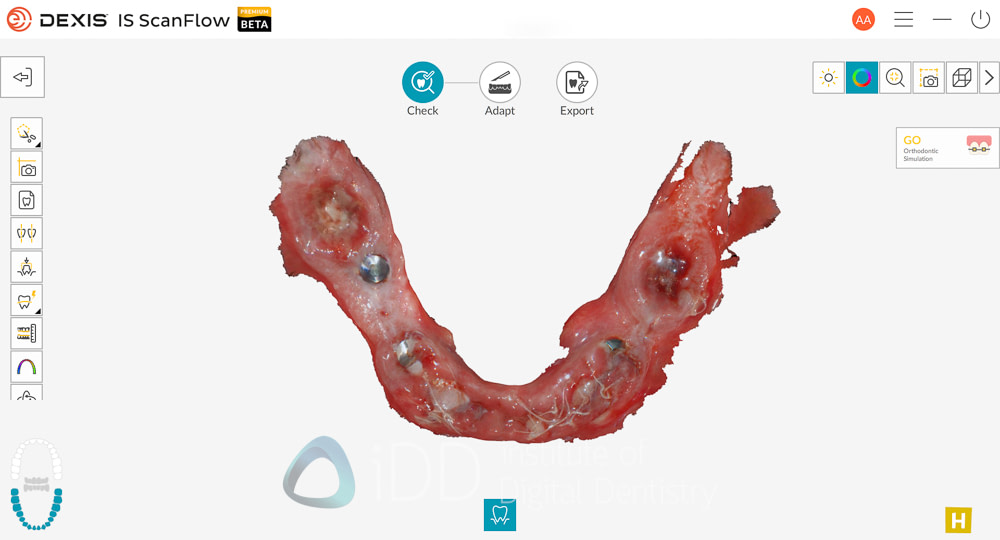
The DEXIS IS 3800W handled all indications well. From crowns to implants and edentulous.
The software itself stitches images quickly. The only issue I found was that sometimes there would be gaps in the scans that would be impossible to fill by scanning over them. This was very frustrating, but it seems that recent updates have solved it. The company is constantly updating the software, which is nice to see.
While scanning the texture is like a cartoon and a little low res, it becomes 'lifelike' after post-processing. The resolution of the final texture looks a little low res, but I have to say these are some of the most photo-realistic scans I have seen. I have had many people comment when I post examples on socials if it is an intraoral camera.
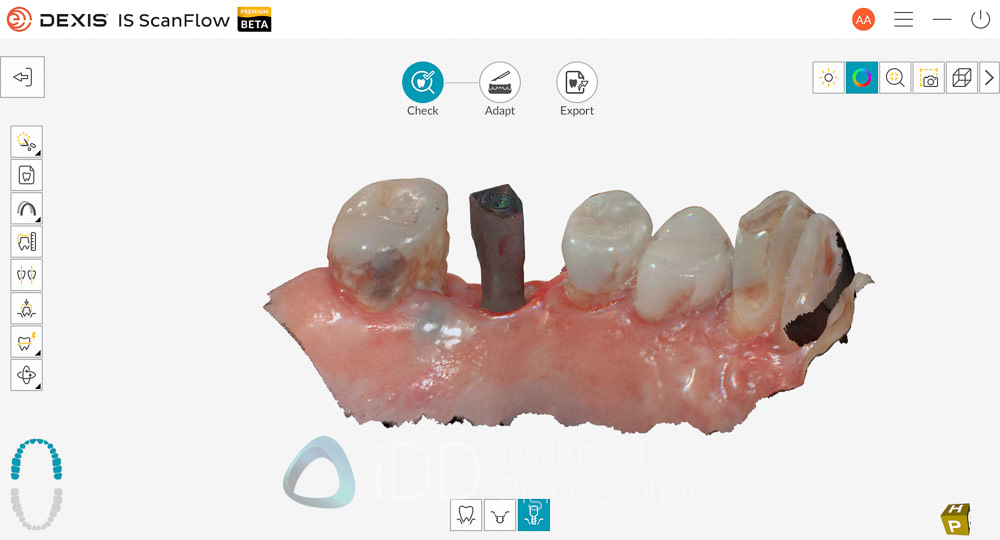
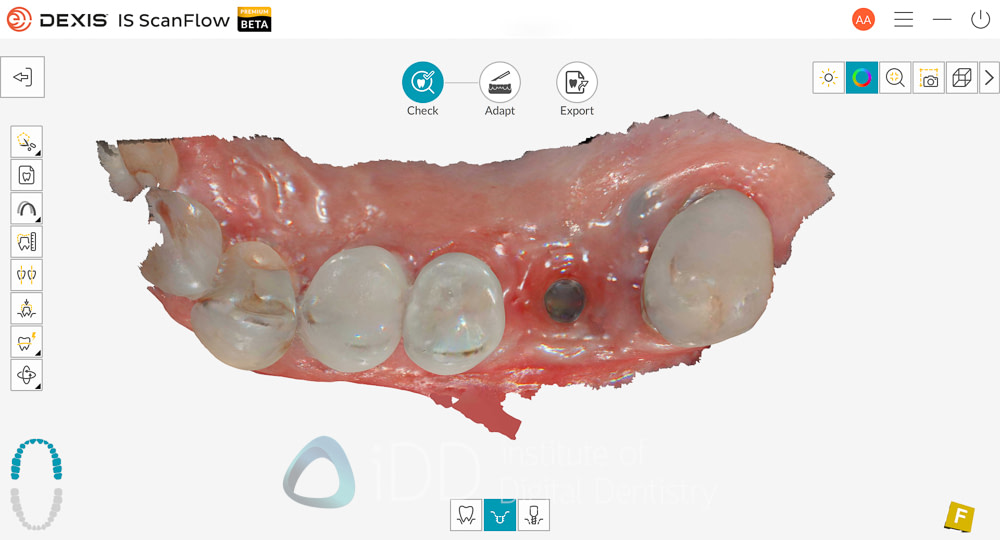
Lifelike scanning textures.
One thing I did note is that the textures kind of get thrown off if there is blood in the vicinity, like with deep preps. The texture in these areas looks strange. Although when turning off the colour, it looked a lot better. You can see an example of this in our iDD Compares posts.
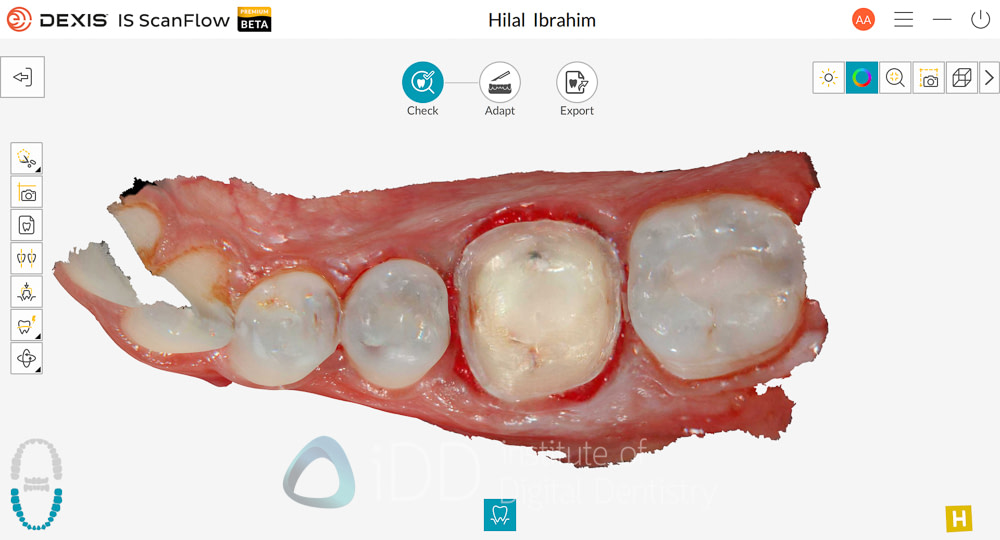
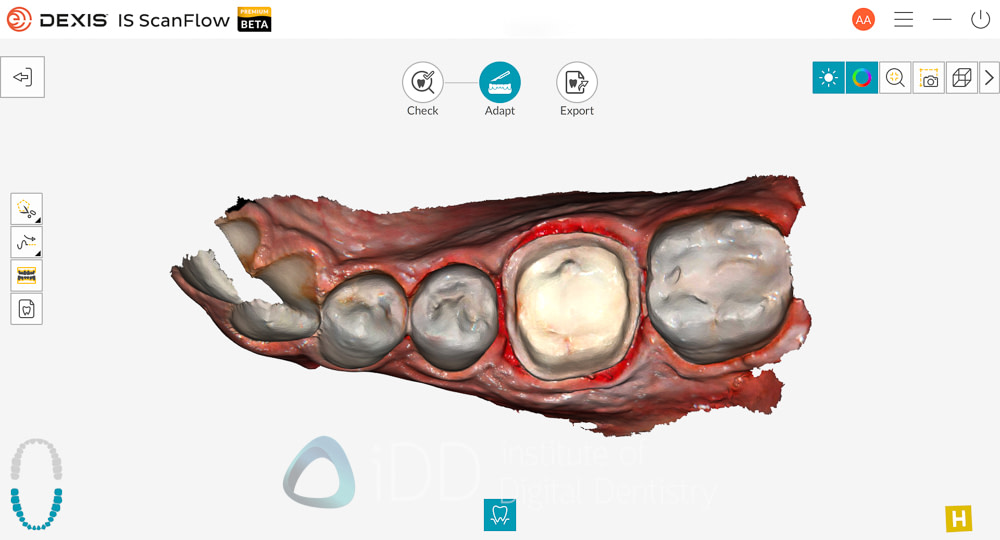
Turning 'color' on (left) and off (right) results in a totally different texture appearance.
The DEXIS IS 3800W AI does a good enough job, but I wish it was more aggressive. You can definitely see it working because when you turn the AI off, the scanner picks up a lot more artifacts than when it is on. However, I found the scanner picks up soft tissues like the cheeks more than other leading IOS.
This was not the end of the world, but it means when using this scanner, you really need to make sure your soft tissue retraction is on point. Otherwise, the AI worked well to ignore the tongue, which is interesting as it didn't do nearly as well with the cheeks.
Day-to-day scanning was easy, and I never had a major issue scanning with the DEXIS IS 3800W. It is a scanner that works, connects with the full DEXIS imaging ecosystem, and comes with amazing DTX Studio software. I expect more from DEXIS on the scanner. This market is all about software, features, and cost now.
Overall, the DEXIS IS 3800W is a fast scanner and you can see it in action in the video below.
DEXIS IS 3800W Design, Build Quality and Ergonomics
The IS 3800W is the most lightweight wireless intraoral scanner on the market. Which is a pretty impressive feat, especially considering it is 3 years old. The overall product design is well thought out, giving it a premium feel and making it easy to use.
It comes with 2 different interchangeable tips (regular and side) with an option to order a smaller posterior tip too.
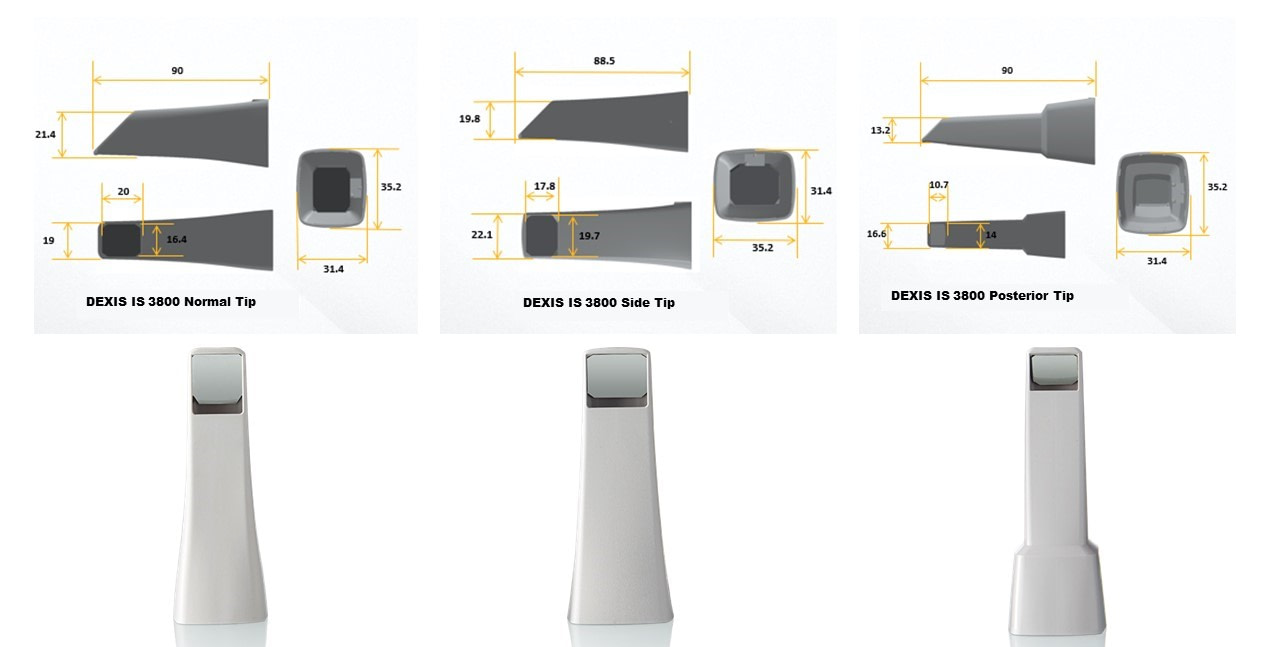
The IS 3800W is weighs 240 g.
This makes it one of the lightest wireless scanners on the market. Lighter than the Medit i700 W (328 grams), AS 200 E (245 grams) and TRIOS 5 (299 grams).
Not only the wireless scanners, the IS 3800W is lighter than almost all intraoral scanners, not including some of the tiny products that came out in 2024.
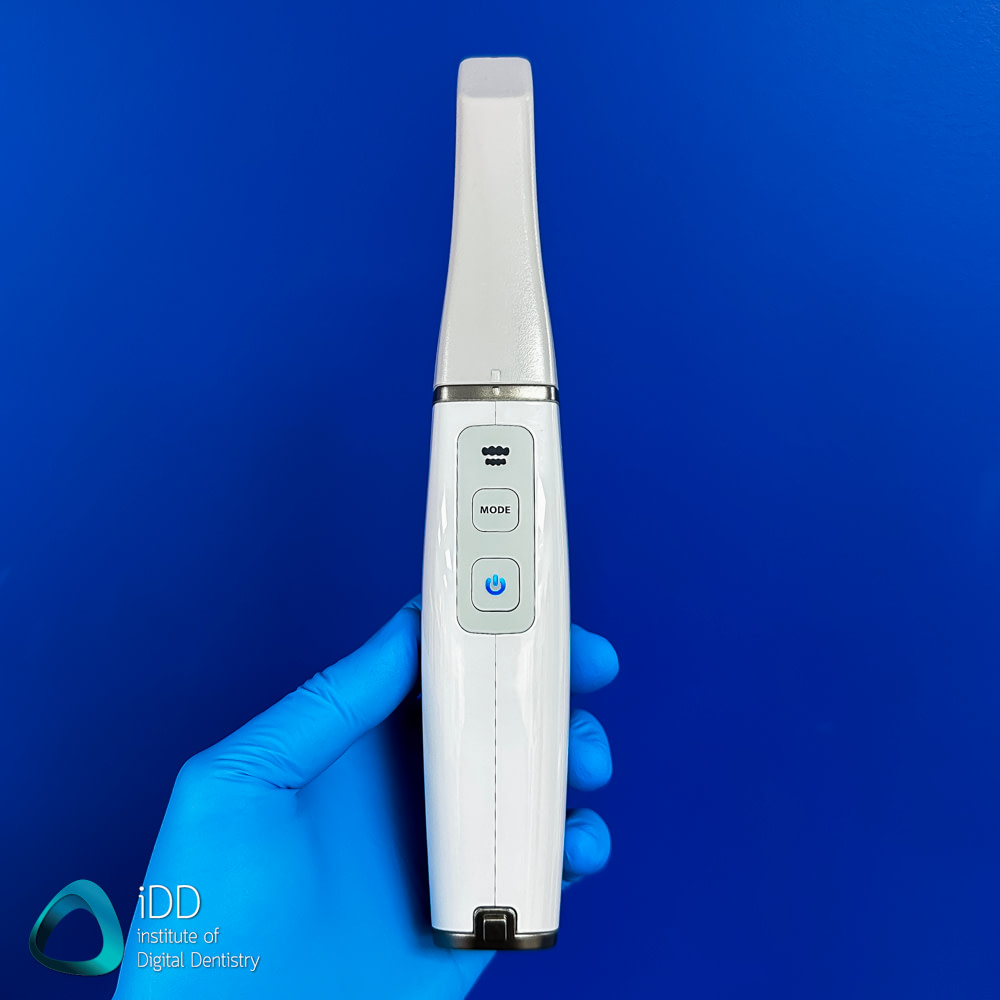
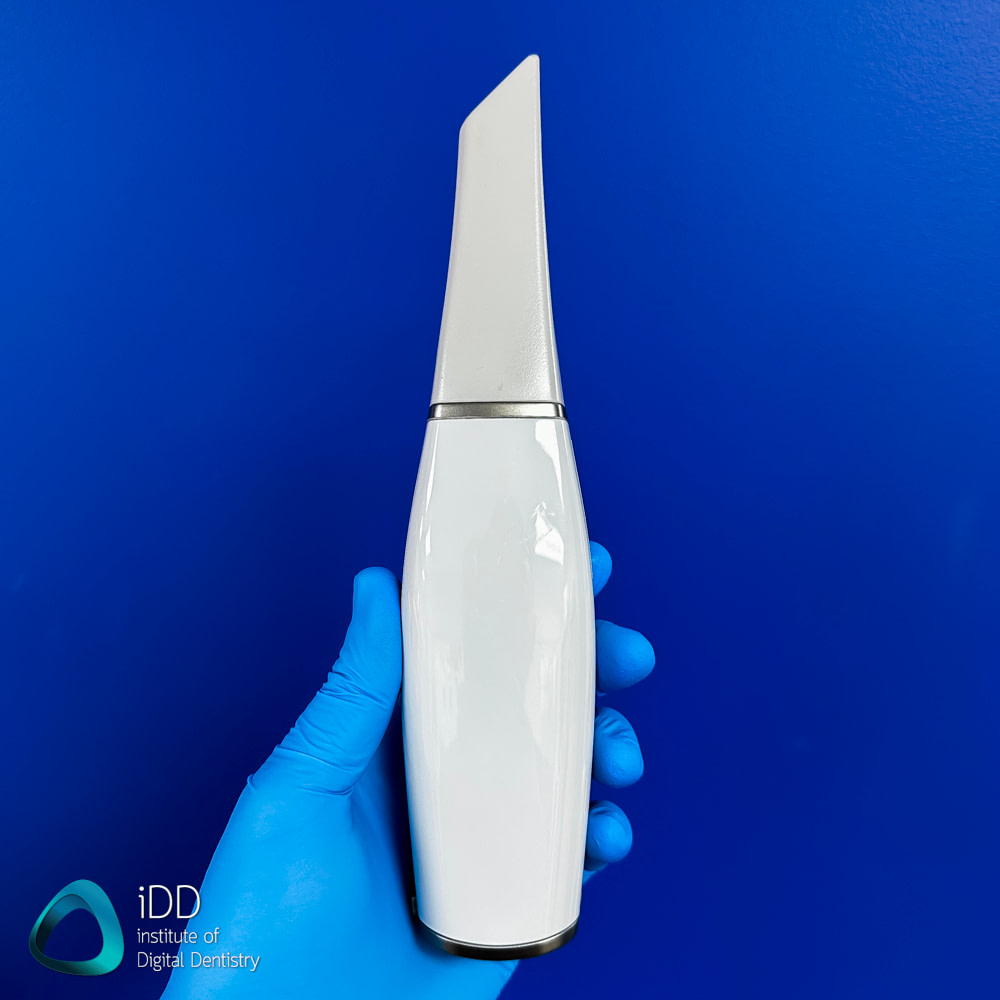
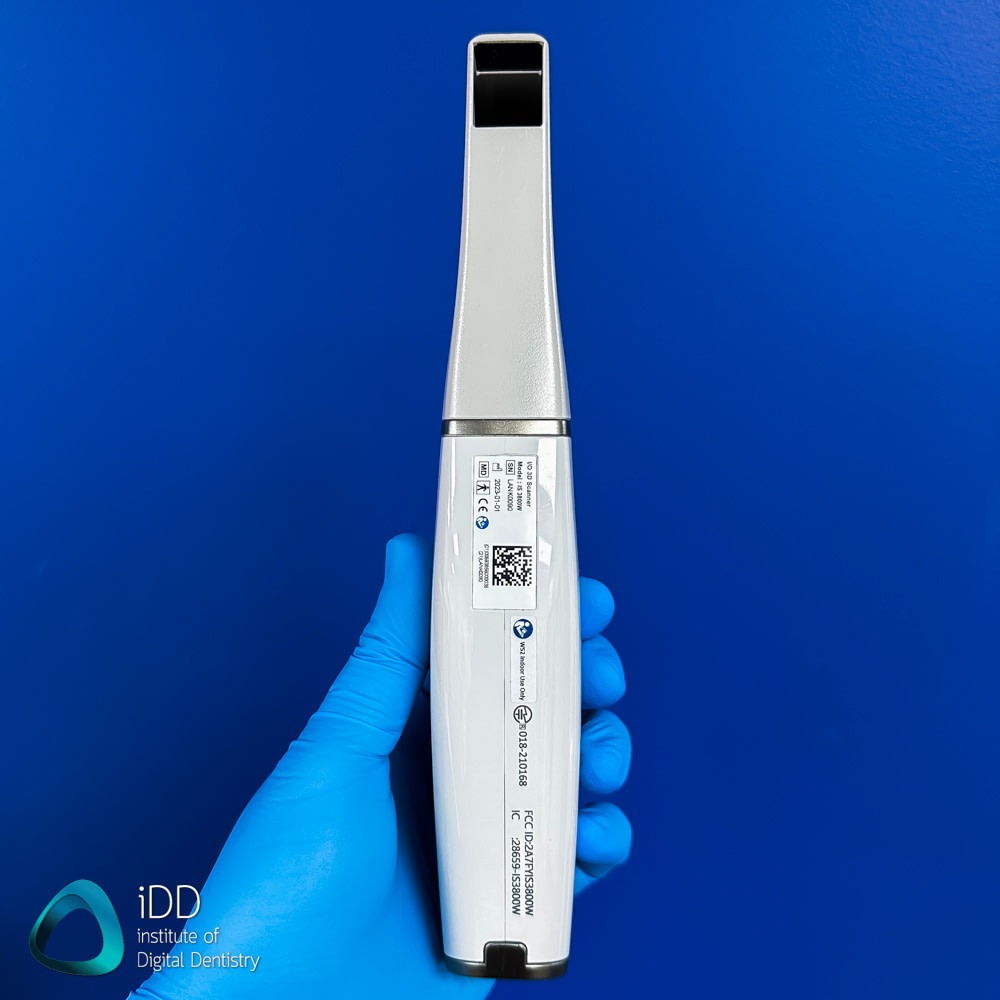
The build quality once again is very good. It is a plastic build but feels solid. All joints are seamless, etc. One of the selling points of the previous generation IS 3700 was that Studio F. A. Porsche (yes, that Porsche) designed it. Thankfully, the company has stopped with that message (because I don’t think dentists care that much) but you can't say it is not a nice design. The IS 3800W shares the same shape as the previous generation scanner.
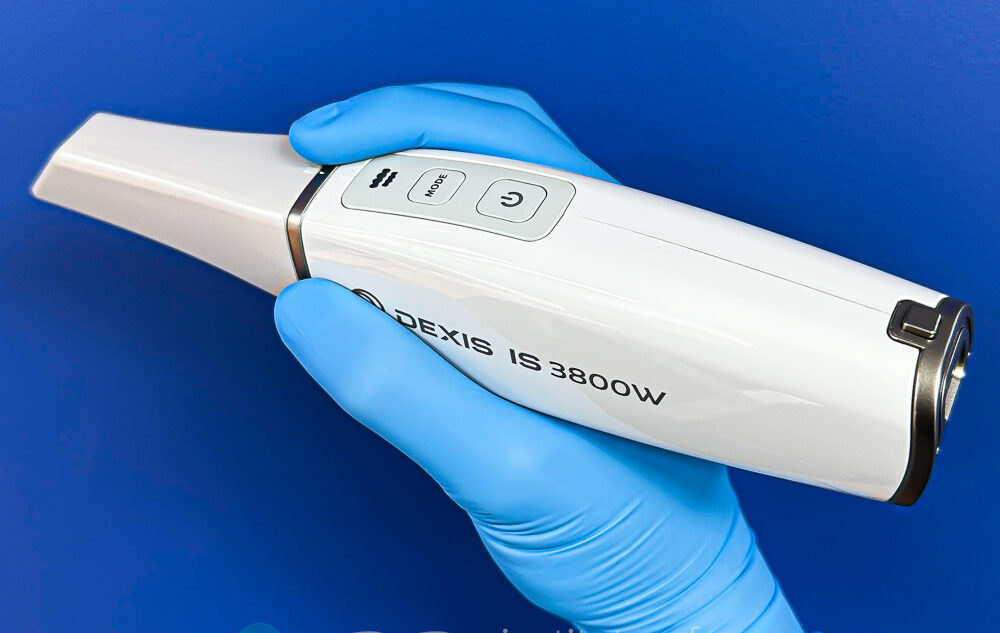

DEXIS IS 3800 (left) and the previous generation 3700 (right)
There have been enormous improvements regarding the scanner buttons compared to the previous generation 3700. For one, the scanner buttons are closer to your finger rest (it used to sit right at the back of the scanner in the 3700). Two, before there was no start and stop scanning button, now there is (thankfully).
One thing I found annoying is that the scanner buttons are not in easy reach when you hold the scanner in a pen grip, so I had to press the on button before going into the mouth or press the button with my other hand. To improve the next-generation scanner, it needs to be moved closer to the scanning tip. Apart from that, nice and ergonomic.
There are two buttons on the top of the scanner - one power looking button to start and stop the scanning process, and one mode button which goes through the different scanning windows (upper, lower, bite).
The scanner is available in two configurations - laptop or sold with a cart called the DEXIS IS Voyager (pictured below). The cart works well and looks modern. It includes a touch screen, and this is a nice option to have.
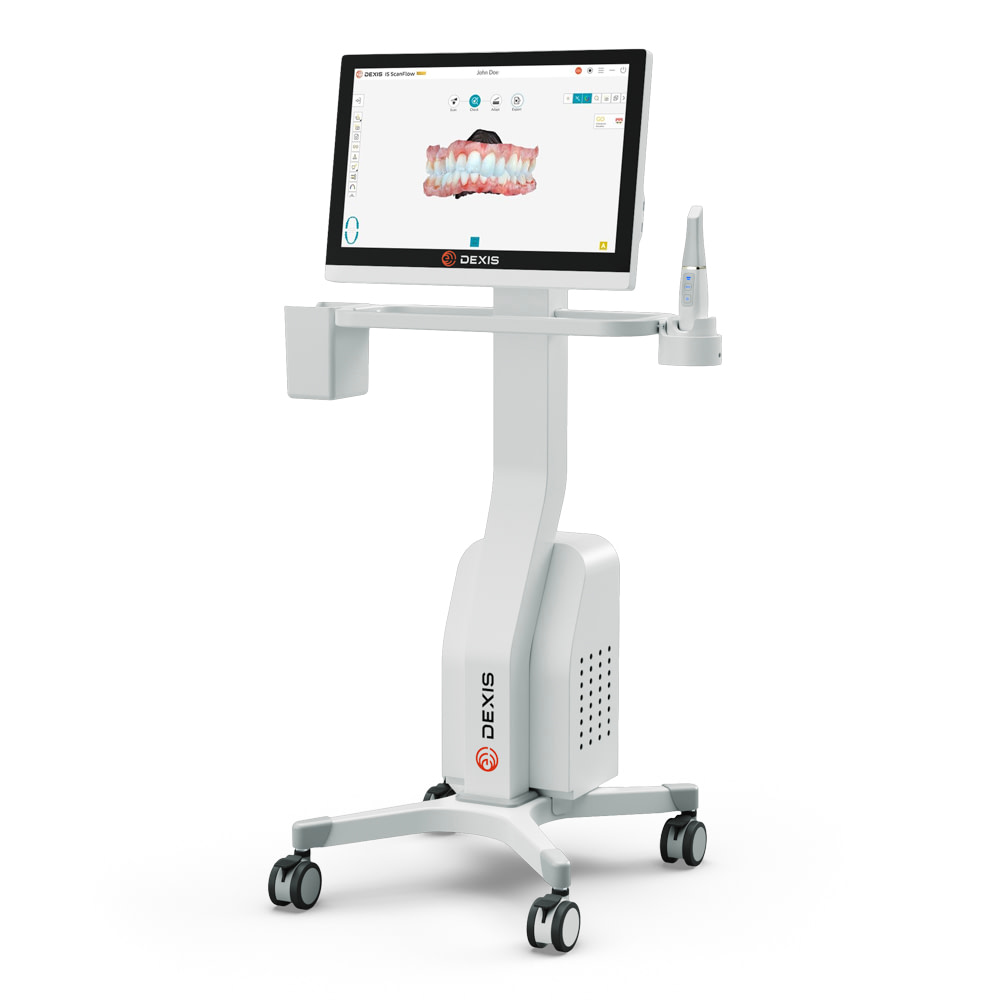
As mentioned, the scanner is wireless scanner. It comes with 2 batteries and a backup cable should you need to use it as a wired scanner.
The scanner cradle doubles as a battery charger. This feature works well and results in batteries being usually always charged. Assuming you mount the scanner into the cradle and plug it in.
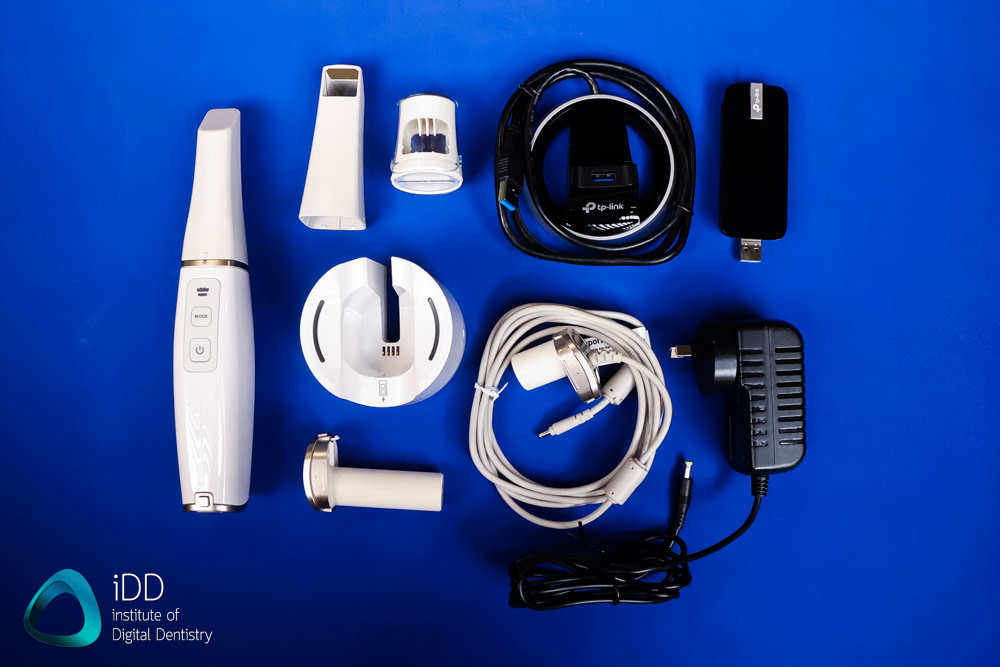
Everything you get, including 2 batteries and a back up cable to enable the scanner to be converted as a wired scanner if required.
There is also an optional battery charger, where additional batteries can be charged outside of the scanner cradle.
Overall, a well-designed wireless scanner and quite impressive given it was released 3 years ago.
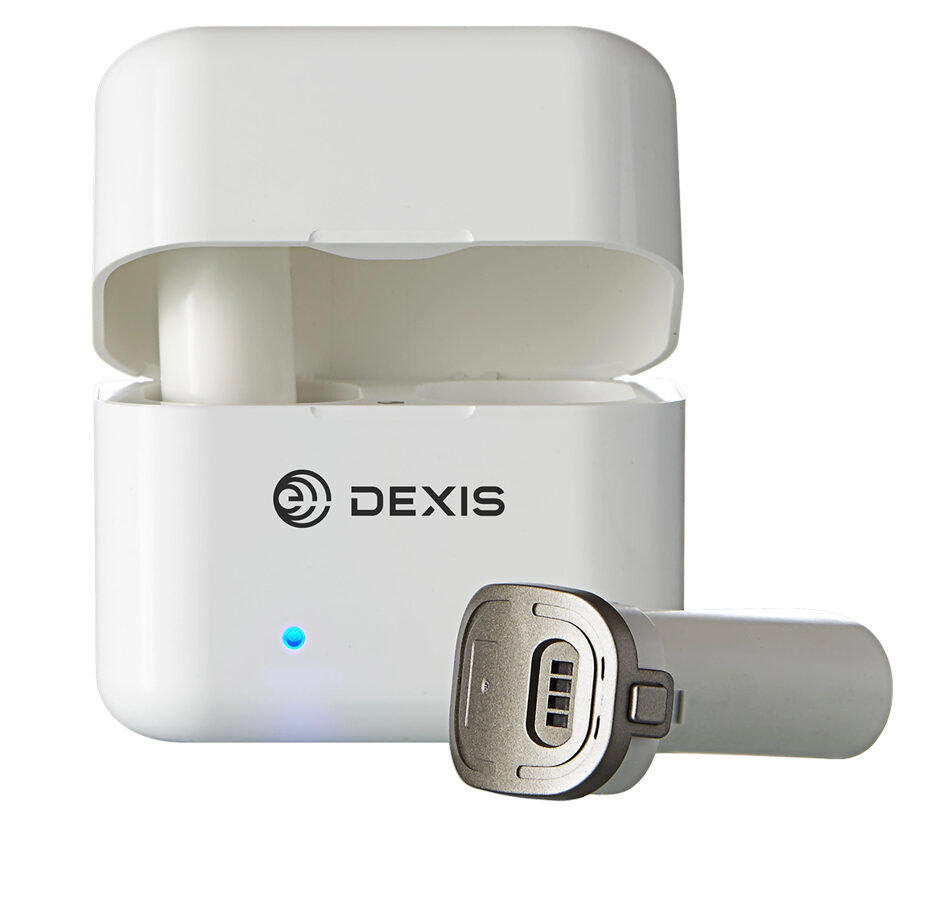
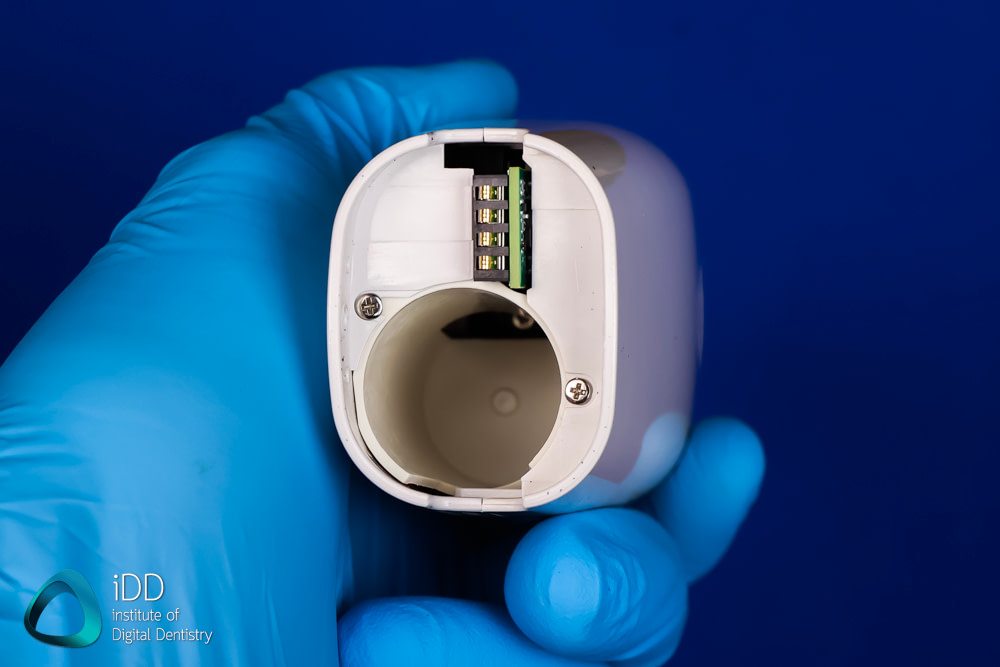
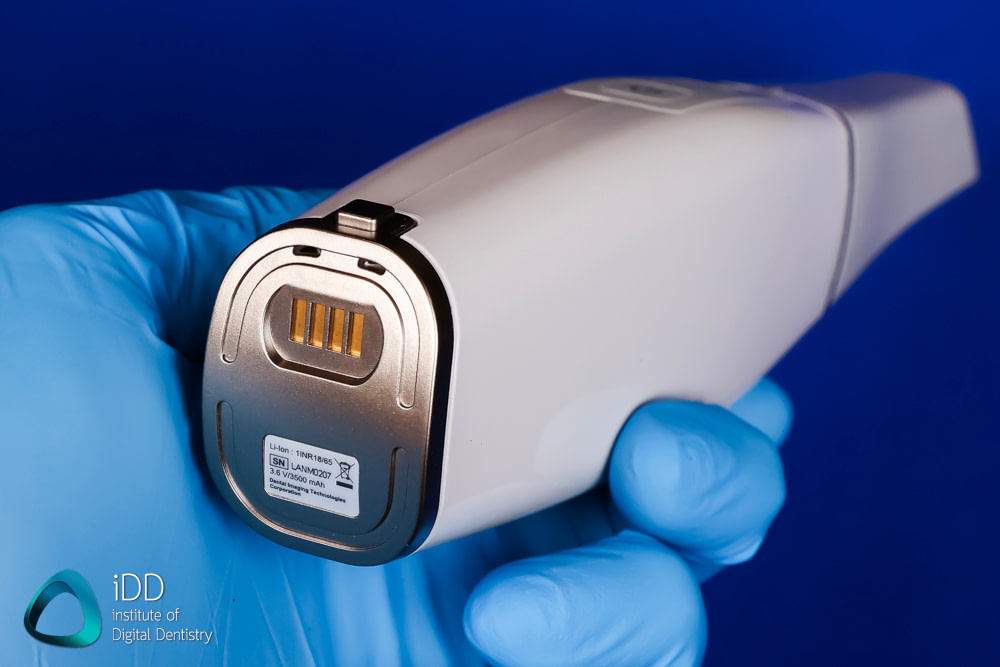
The wireless connection is established using a TP-Link USB dongle, similar to TRIOS 5. It is OK and works. I just find these dongles to be a little tacky and it feels like a better solution could be thought up. You can connect this dongle via USB 3.0. The dongle does use point-to-point WiFi access and has a stable connection all the time. The software also makes it easy to connect to it.
Lastly, battery life was good. The company says the batteries are designed to provide approximately 1 hour of continuous scanning through 500 battery charging cycles, after which the battery's charging power diminishes by 80%.

DEXIS IS 3800W is next to the iTero Lumina and Aoralscan 3 Wireless. It is the smallest wireless scanner on the market.
DEXIS IS 3800W Accuracy
Regarding accuracy, because the DEXIS IS 3800W has been around in the market for some time there are actually some pieces of literature on its accuracy - you can see them here and here. It is a proven accurate scanner.
Research does not show any clinically significant differences in accuracy between this scanner and any other market leader. When I personally compared scans taken using the DEXIS IS 3800W to other IOS devices I also could not see a significant difference either, even when comparing meshes many times. You can see all our comparison posts here.
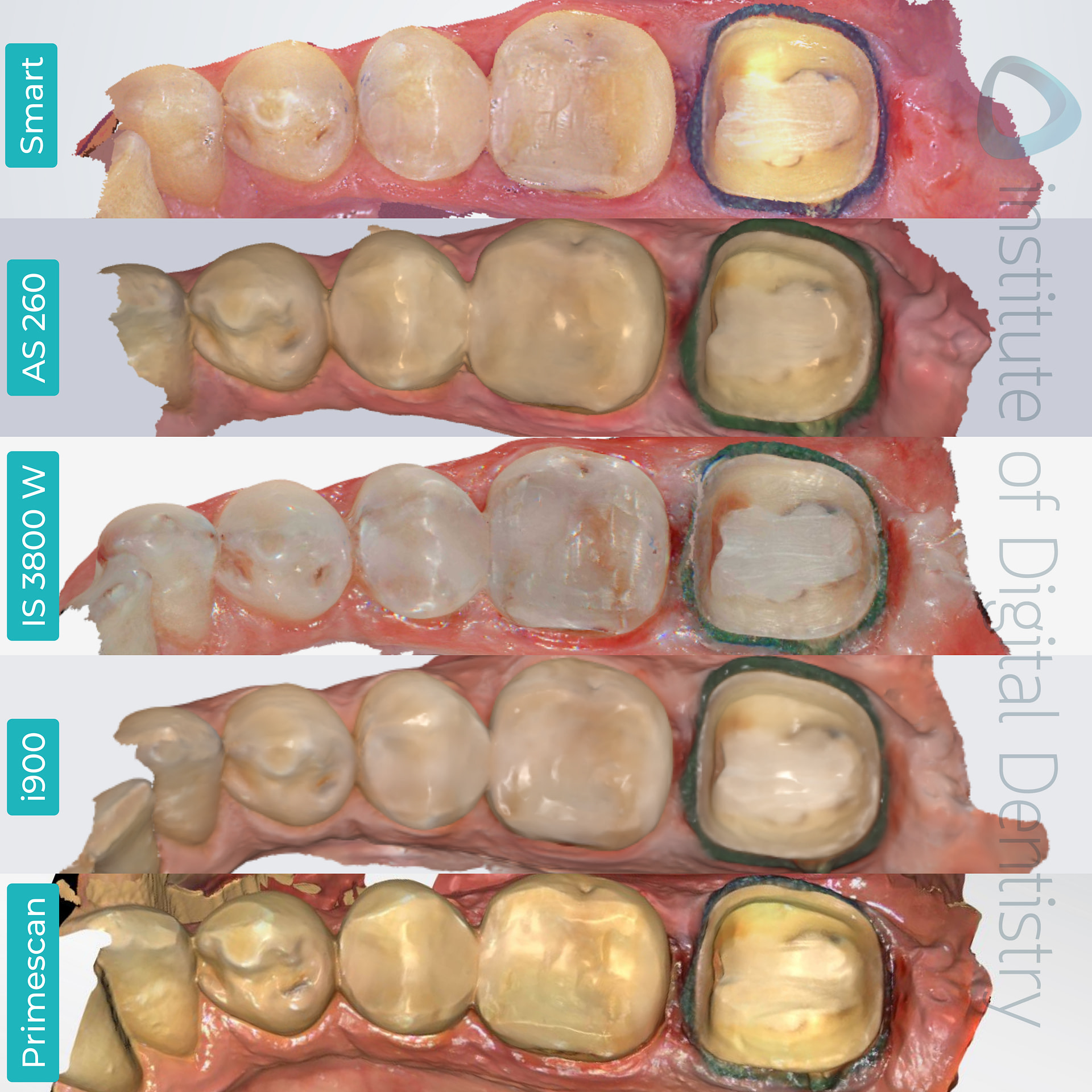
The processed, colored scans of the same tooth preparation were captured using five different scanners, as previewed in their native software.
Download the Full Review PDF

Download the full 24 page PDF to get a full copy of this article to read later.
Get a high resolution printable copy of this review.
DEXIS IS 3800W Scanner Tips + Calibration
The DEXIS IS 3800W uses autoclavable scanner tips. These tips are non-reversible, placed in one way and come in a few different configurations (small, large and side) as mentioned prior.
You can autoclave each tip 110 times. The cost of these tips is 110 USD, so approx 1 dollar per patient.
The scanner comes with 2 scanning tips in the box and an optional smaller posterior tip is also available.
The scanning FOV of these tips is 20 x 16.4mm for the standard tip and 17.8 x 19.7mm for the side tip with a scan depth of 18mm.
There is also a colour calibration unit in the box. Otherwise, this is a calibration free scanner.
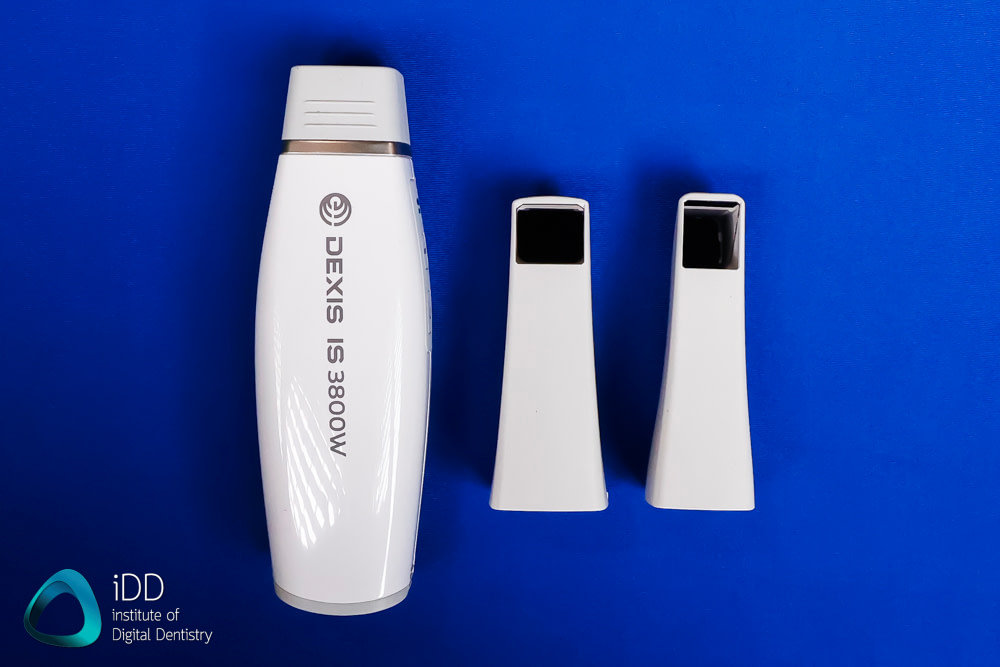
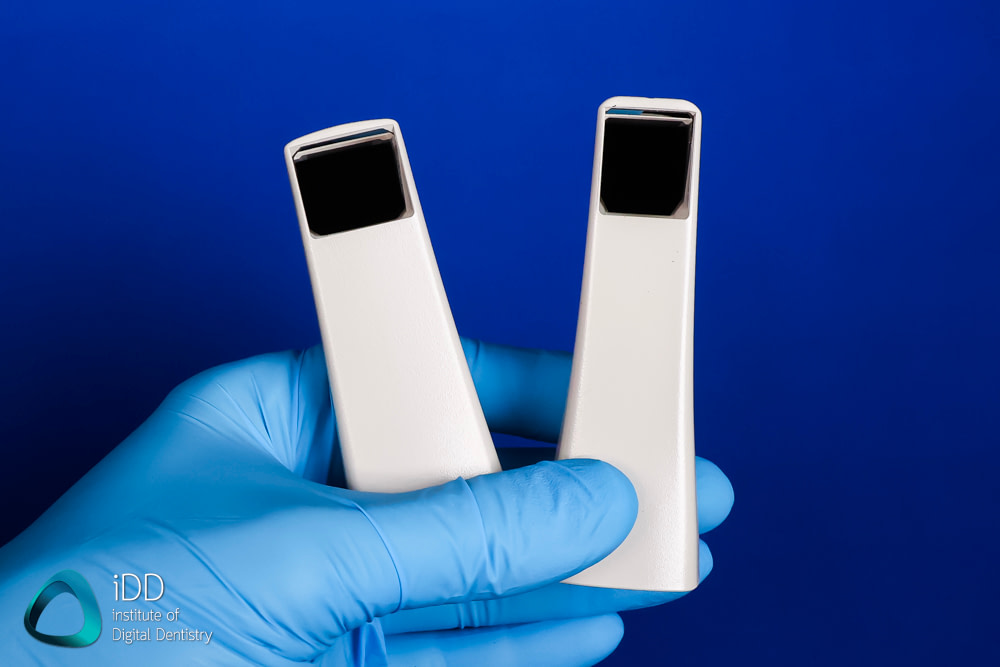
DEXIS IS 3800W Software - IS ScanFlow
The software that runs the scanner is called DEXIS IS ScanFlow. Over the years, the developers have greatly improved this software. It is far superior to the software that used to come with Carestream Dental scanners when we reviewed them.
As scanner hardware of all intraoral scanners is plateauing to a certain degree and all scanners are ‘fast’, software is differentiating the different products. This software delivers a lot of things well.
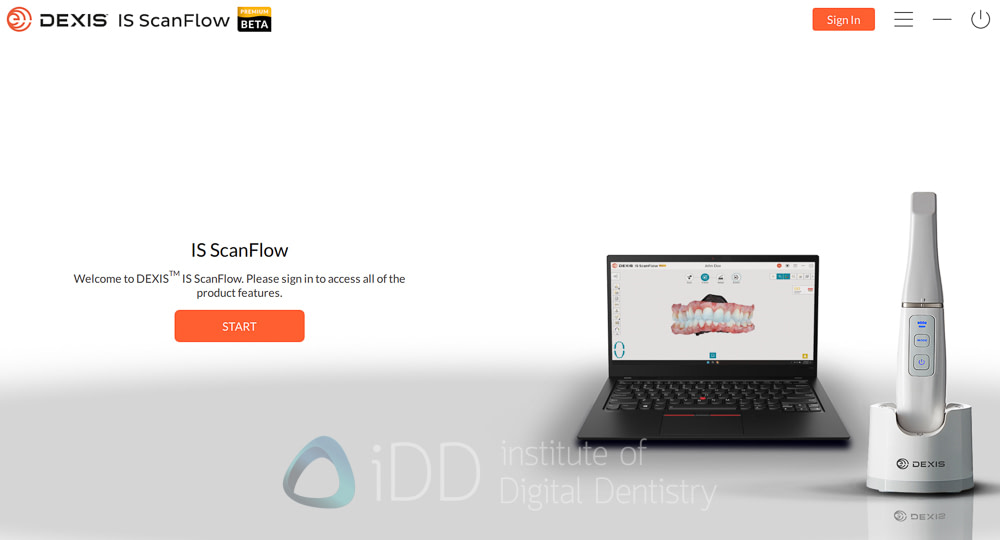
DEXIS IS ScanFlow is the software that runs the scanner.
There is a large add patient icon and from there you can easily create a patient file and then start scanning within a few seconds.
The software itself shows careful planning by the DEXIS team, providing a vast array of guided workflows for nearly every possible indication.
In fact, this is one of the most flexible software programs I have seen, on par with Medit, in terms of how many extra scans you can add if you require. It is quite good. Maybe a little too flexible as I found myself given a few too many options for implant scans, but once you get your head around it, it is quite good.
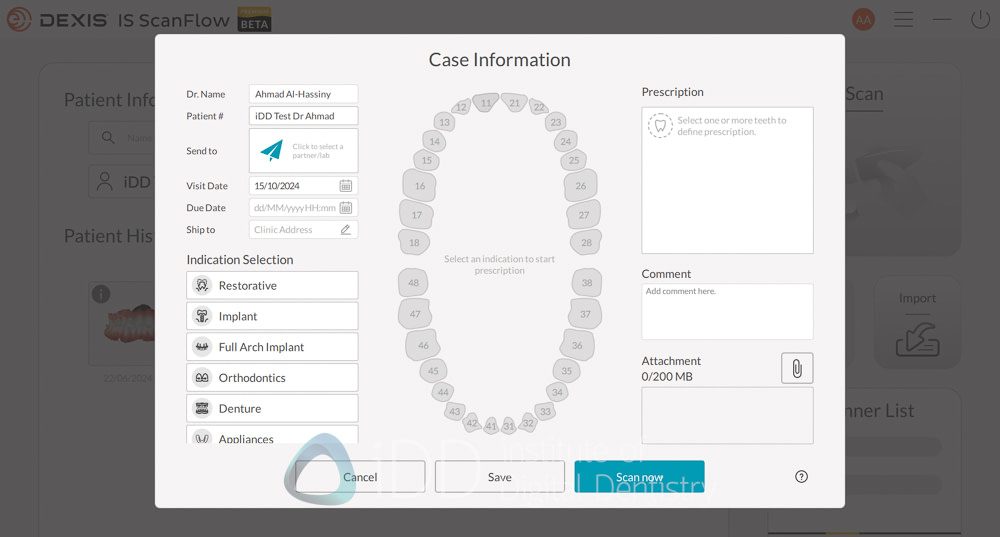
The DEXIS IS 3800W software has all the main scanning software features you want including being able to pick all the main workflows (pros, implants, edentulous etc), having a range of materials in the lab form, the ability to add attachments, add comments, send to connected labs directly, etc.
It goes further than that by also having workflows for more complicated procedures like full arch implants. Which is a nice touch and shows this scanner software is being designed for all indications, not just the basics. It also has automatic scan body matching via AI which is becoming a more and more popular scanner software feature.
Between the lab sheet and starting the scan, there is a 20-second or so period for the scanner to initialize, and once everything is connected, you are ready to go. Then the scanning software itself opens, and it looks good with a modern UI. Maybe a tad cluttered for 2024, but that is a subjective taste.
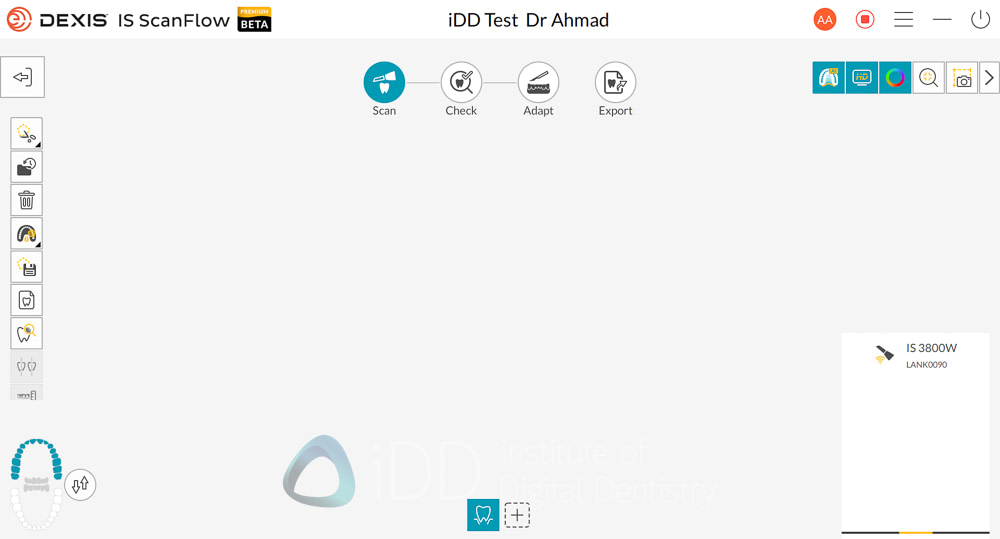
Here you again have full flexibility. Turn on / off AI, HD or not scans, magnify, etc. There are also all the usual scanning tools, like cutting and locking parts of the scan, undercut analysis, etc. Notably, the 3800W also has shade detection, which is a rarity in the scanner market of over 30 different scanners.
To me, one of the best parts is how easy it is to connect the wireless scanner to the software. It really does make it simple and that just helps minimize frustrations with wireless IOS. There are also clear indications of battery life etc on the screen.
After scanning with the DEXIS IS 3800W, the software provides you with three unique options to refine the scans - Low, High, and Standard.
To me it feels once again that the scanner software does a little too much in terms of giving you flexibility and options and I often just picked high in fear of lack of details, but I guess it is nice if you are just doing study models to have an option that is faster to post-process. Using the high setting, post-processing did take 2-3 minutes. A little on the long side.
After post-processing, you have all the standard IOS tools and a couple of interesting color toggles to change the texture from the lifelike texture to something that is more of a cartoon but looks much more HD.
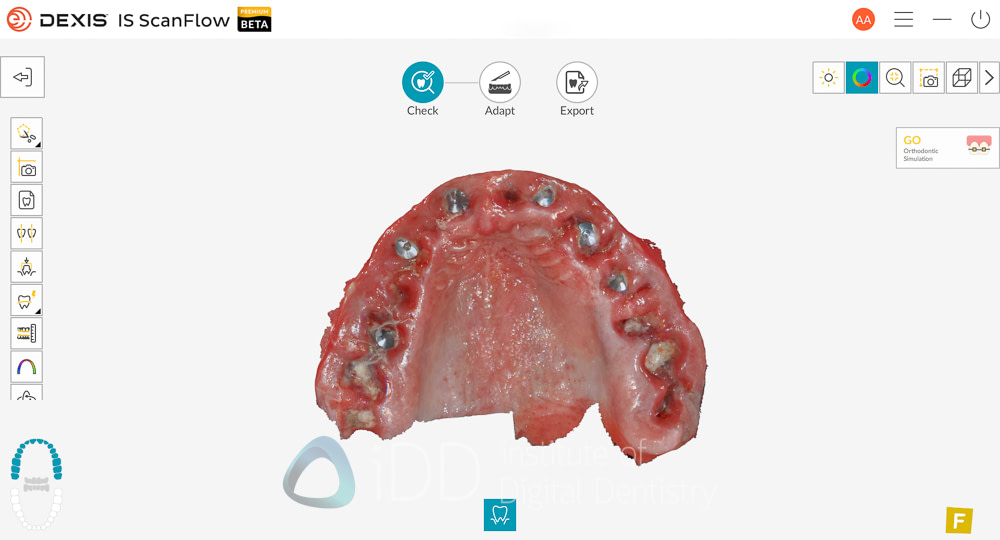
You then can export into either PLY or STL and, of course, the scanner has direct integrations to SPARK aligners (also owned by DEXIS) and interestingly, SprintRay.
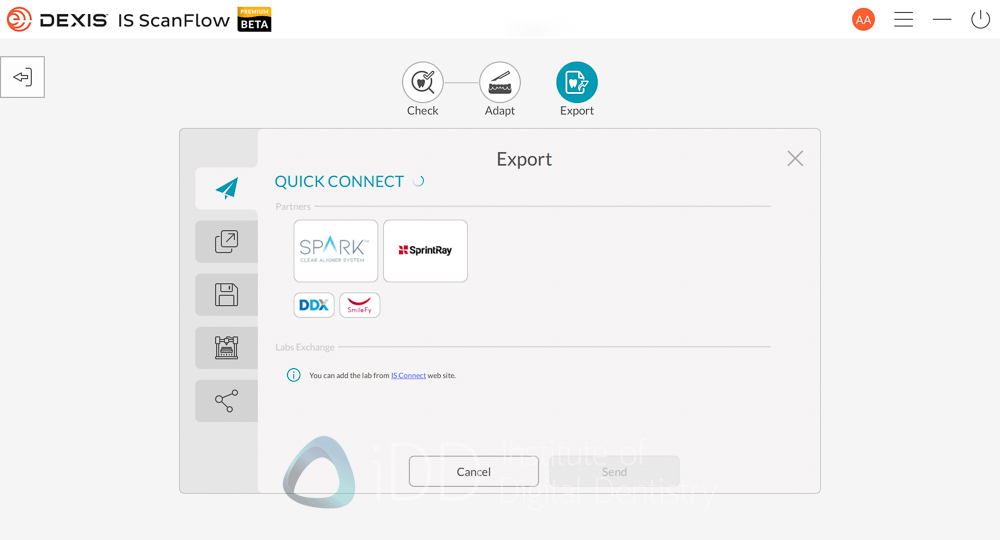
DEXIS IS 3800W Software Apps
The DEXIS IS 3800W IS ScanFlow software has 2 main apps - a model builder and orthodontic simulation.
The model builder is directly usable on the post-processed scan screen called adapt since it is built into the scanner software itself. This is quite smart and means you don’t need to open another software or program. Additionally, it means that models can be quickly created and efficiently printed through the SprintRay integration.
As with all model builders these days, it is easy to use and works well. A model builder with a scanner software has become almost an industry standard.
Next is the ortho software. The textures look average, not lifelike, like the scans, and not quite on the same calibre as the iTero ortho simulation. But it has to be said, it is very easy to use. Single click and it works. This is a far cry from what the older ortho simulator used to be like on the Carestream Dental software - which was very complicated, looked worse and also had a disclaimer screen that non-specialists should not use it. Thankfully, all that is gone, this is a quick and efficient ortho simulator that products some pretty decent proposals.
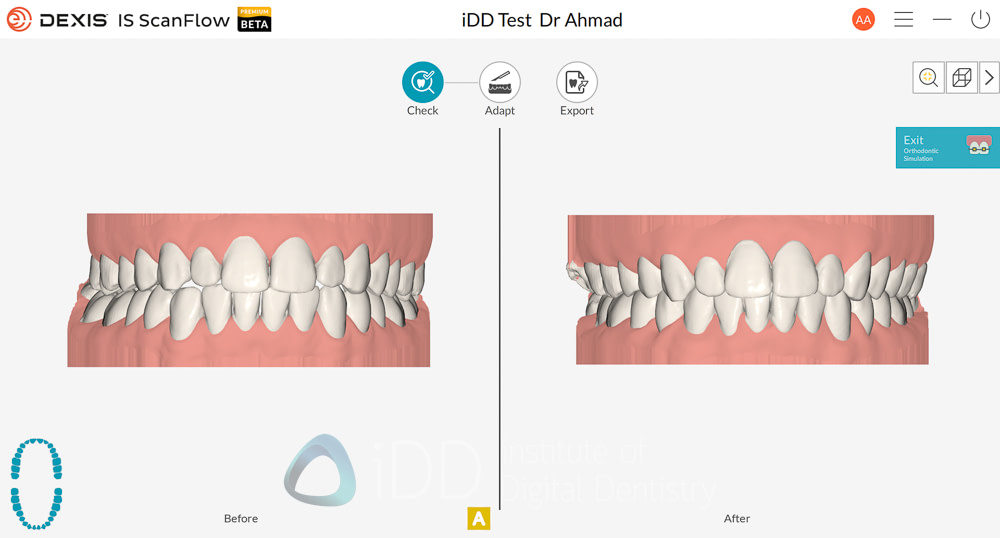
DTX Studio Clinic
OK, so this is the most impressive software I have seen made by a scanner company and to be honest, the best feature of the DEXIS IS 3800W. As I have alluded to many times, all scanners work. It is now a software game and what DEXIS has been building I feel needs to be highlighted, because before stumbling across it in Chicago Midwinter 2024, I had no idea this exists.
So what is DTX Studio Clinic? Well, it’s a digital imaging ecosystem that is packed with a ton of smart tools and AI. Think of it as the imaging home base that DEXIS is building that also does diagnostics, treatment planning and connects to your DEXIS scanner directly.
So basically, it opens IS ScanFlow for you when you are ready to scan, or some version of it and allows for AI-enabled integration of your scans with your 3D imaging workflows. DTX Studio is a software to consolidate all your data - 2D, 3D, intraoral scans, and photography into a user-friendly platform. The best part is the AI features.
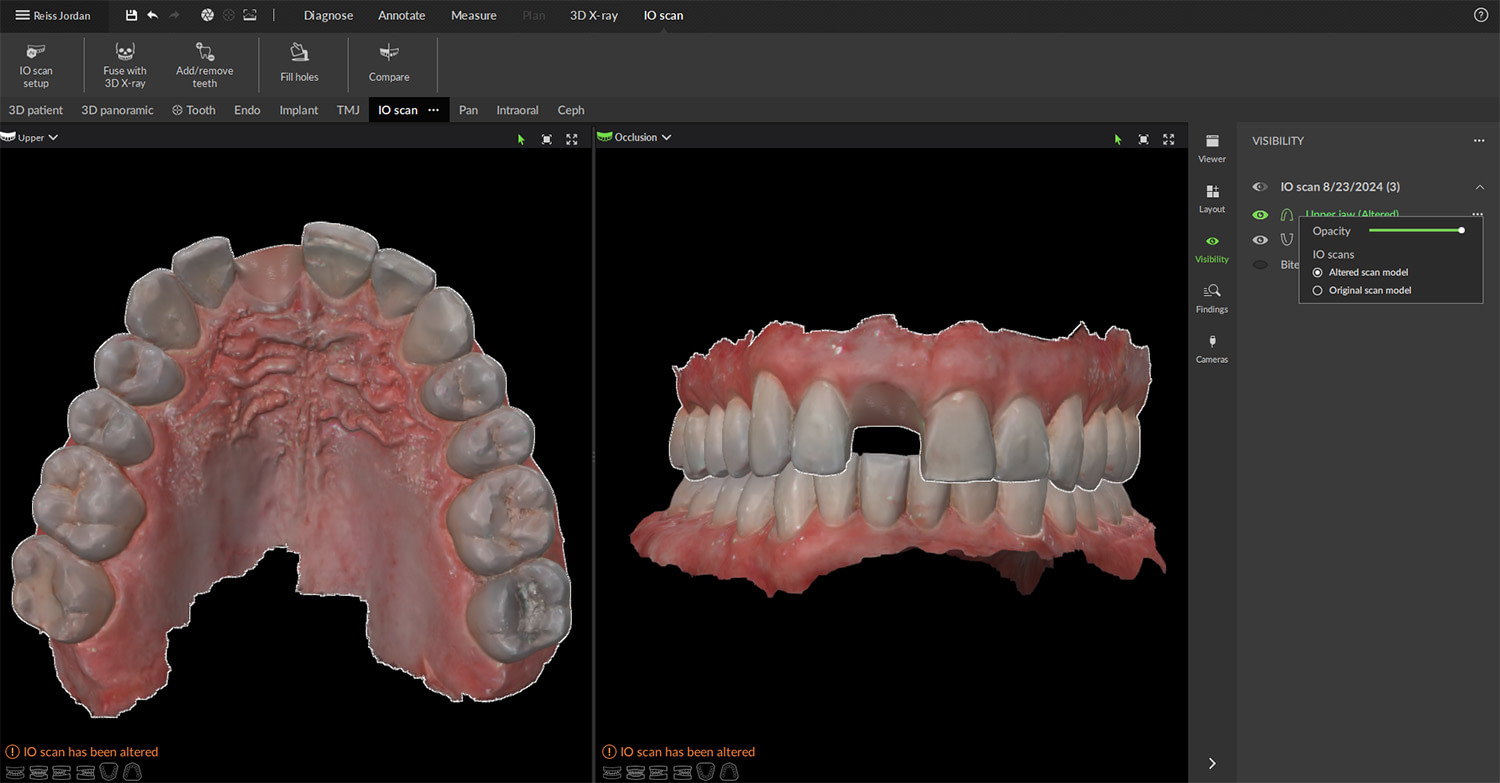
DTX Studio is so feature rich I will try summarise all the cool things it does below:
- Uses AI to organise all images together in groups. If you load up PBWs, intraoral images, PAs and a FMX series, it will arrange this all correctly and smartly via AI. If you hover over any tooth on the chart - it will show you all related data.
- Also aligns and accepts CBCT data and identifies tooth numbers, missing teeth etc.
- AI nerve tracing, pano curve and TMJ view set-up
- Identifies tooth numbers on IOS and AI fuses to CBCT
- Uses AI to extract or create virtual teeth
- Root morphology feature to examine roots for endo.
- Performs AI diagnostics.
- It uses AI to measure airway spaces and reports on these.
- It enables users to generate surgical guides using AI that can be exported.
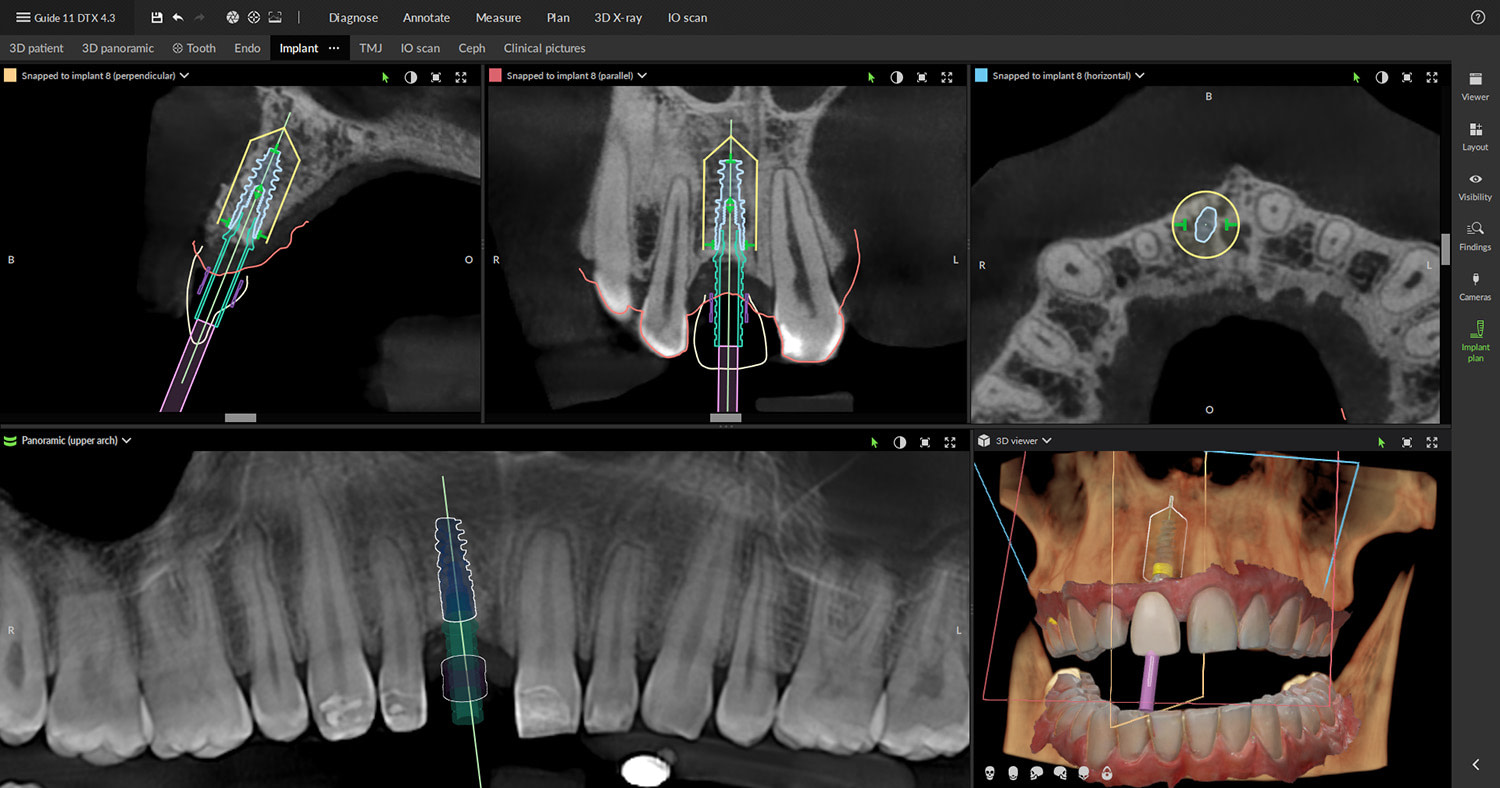
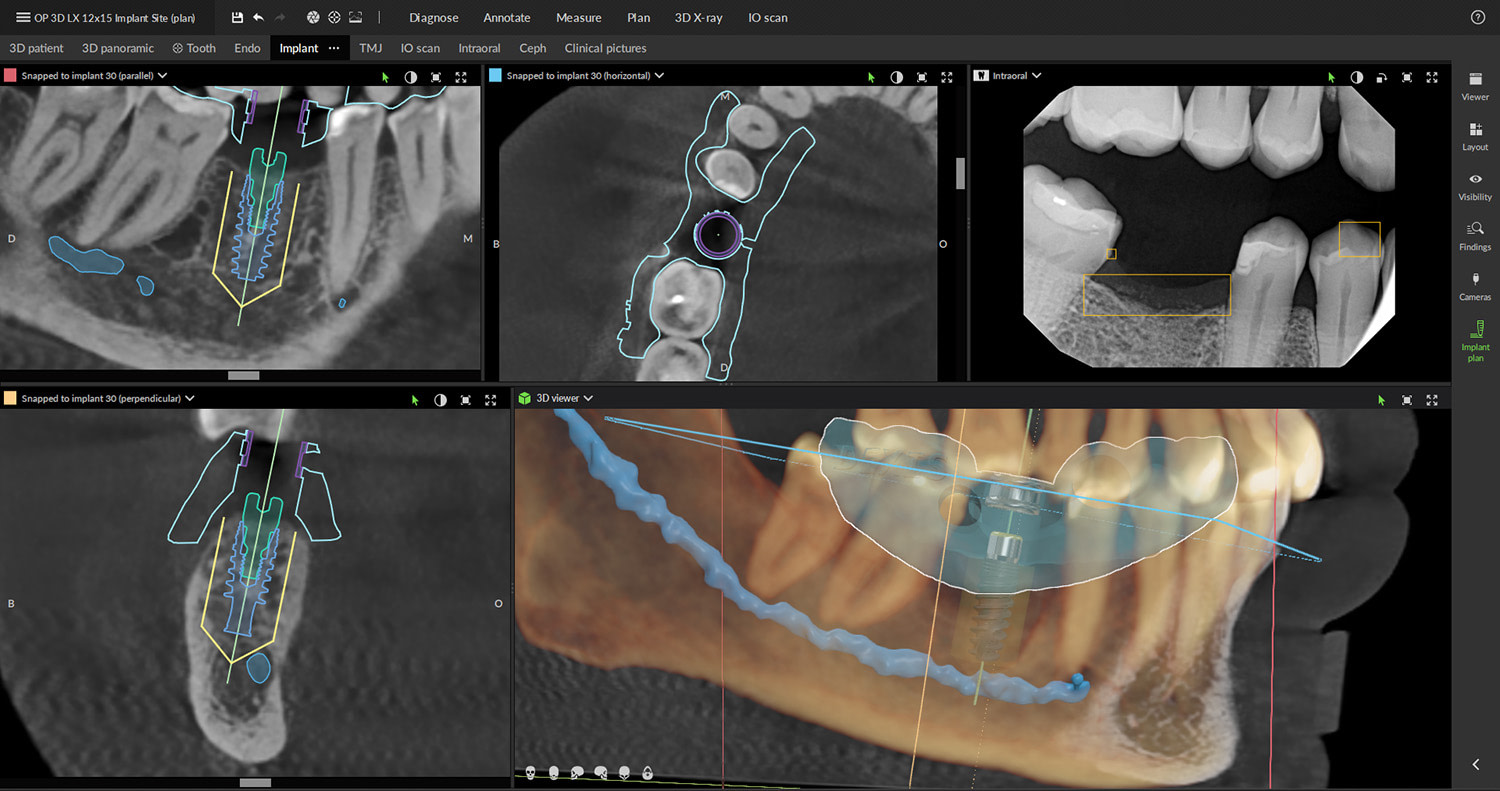
DTX Studio does so much it could be an entire review in itself. The impressive features that Envista is building into this software honestly blew me away, and it's intriguing to me that hardly any clinicians are aware of it.
Why the company doesn't market it more is anyone’s guess, but it is perhaps the best software as a data hub or imaging centre that I have seen any scanner company make.
DEXIS IS 3800W Cost
The price of the DEXIS IS 3800W ranges depending on the market and deal at the time - which is typical with scanners these days. For example, in the North American market, the DEXIS IS 3800W is bundled with a laptop.
In Europe, the price is approximately $15k USD,
including the DTX Studio Clinic software across various geographies.
Note: DTX Studio is not available in all geographies. In the US, the unit price is higher as it includes a laptop and training - around 20k USD typically.
In a world of intraoral scanners that range anywhere from 8,000 USD to 25,000 USD, this places the DEXIS IS 3800W in the middle ground. The DEXIS IS 3800W also has no subscription fees or costs. There is no cost for the case transfer service either.
DTX Studio Clinic is also free, but all the AI features come at a cost after the first initial free year of use.
The cost of AI dental findings using DTX Studio Clinic is $99 USD per month as a starting package. To reiterate, the AI and other added features incur a cost of $99 USD per month as a starting package for the DTX Studio Clinic software, but you can still use the software for free and choose not to use the AI tools.

Conclusion
Even though it was released 3 years ago, the DEXIS IS 3800W remains a decent scanner. A lot has happened and the IOS market has totally shifted. Thankfully, Envista seem to be 100% committed to making this product work as they have invested heavily into the software.
As a scanner alone, it is good. It can scan all indications you want and apart from some strange textures, I found it to be an enjoyable scanner to use. On par with basically any other scanner you will likely be considering. The entire market has basically consolidated to 'good scanners'.
The difference in this product is that Envista can leverage their large portfolio and bundle this with all sorts of products to give you a good deal. Whether it is Nobel / Implant Direct implants, SPARK aligners, orthodontic or imaging equipment. They really have a lot of options here and in a market where the prices are rushing to the bottom, I think they will have to utilize this.
The other interesting thing the company has done is invest a lot into the software. IS ScanFlow software that runs the DEXIS IS 3800W is great. It is super flexible allowing you to do basically everything and anything you want. Maybe a little too flexible and convoluted in some workflows, but I did appreciate the open-ness.
The other incredible software they have developed is DTX Studio Clinic, which is one of the best imaging software to utilize AI I have ever seen. It really is incredible how it aligns all different data sets (2D, 3D, IOS, CBCT etc.) and presents it in a very smart and individual tooth focused way. Then you learn it also can generate surgical guides via AI and a range of other features and I have to ask myself - why don’t they market this hard?
Overall, the scanner is a good option especially if you use other products in the Envista portfolio. Right now, I do not envy the company trying to make their mark in such a competitive intraoral scanner market where products are being sold for under 10k USD commonly and there is a surge of products from China. But they are doing the right things in my eyes by focusing on software, platform and ecosystem and I eagerly await to see what they do with the next generation DEXIS scanner.
Evaluation Ratings
Evaluation Ratings
Scanning Speed
Scanning Flow
Scanner Size
Ease of Use
Scanner Software
Investment Cost
Additional Features
Wireless Scanner
Caries Detection
Software Apps
Model builder, ortho simulation, shade detection.
CAD/CAM Software
None
Subscription Requirements
No subscription fees.
Autoclavable Tips
110 times per tip
Download the Full Review PDF

Download the full 24 page PDF to get a full copy of this article to read later.
Get a high resolution printable copy of this review.


Is it exactly the same as CS 3800?
As carestream is sold is it would be a problem to have a cs3800. Like if dexis software is updated and I have cs, would it be possible to keep using it? Thanks
Yes it is. But with the new DEXIS Software.
If you bought a cs3800. You can use the new DEXIS software – the latest IS ScanFlow software. Contact your local rep. I am told that if support is required for this update, there may be additional fees.